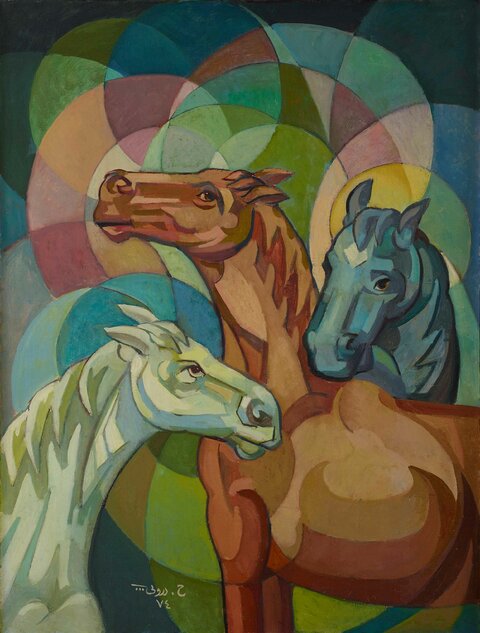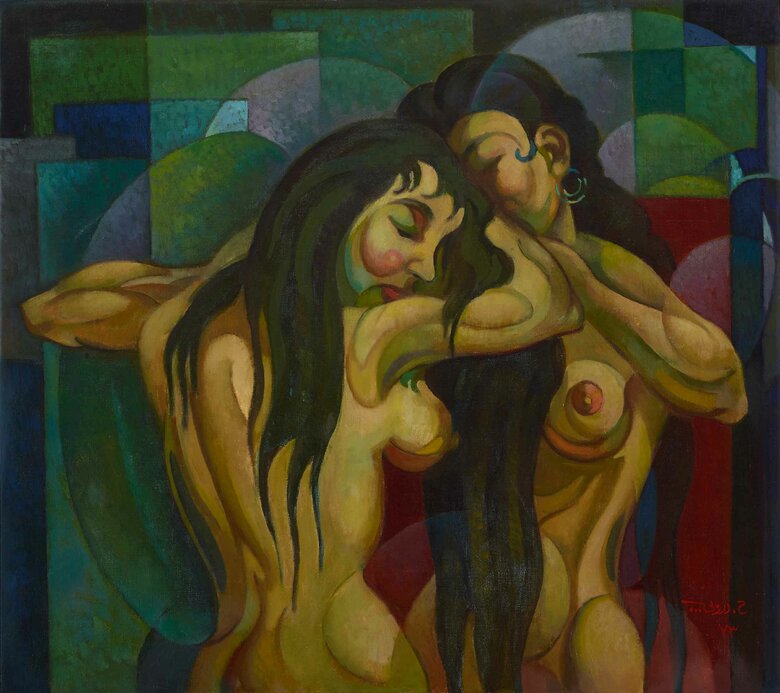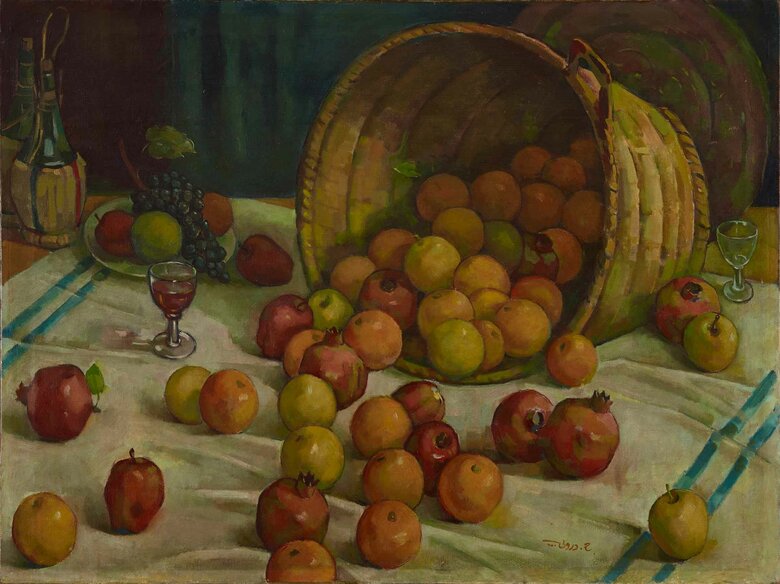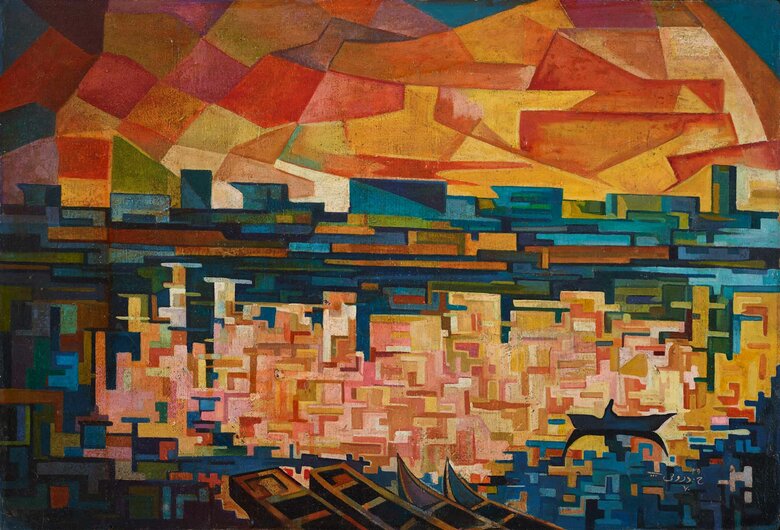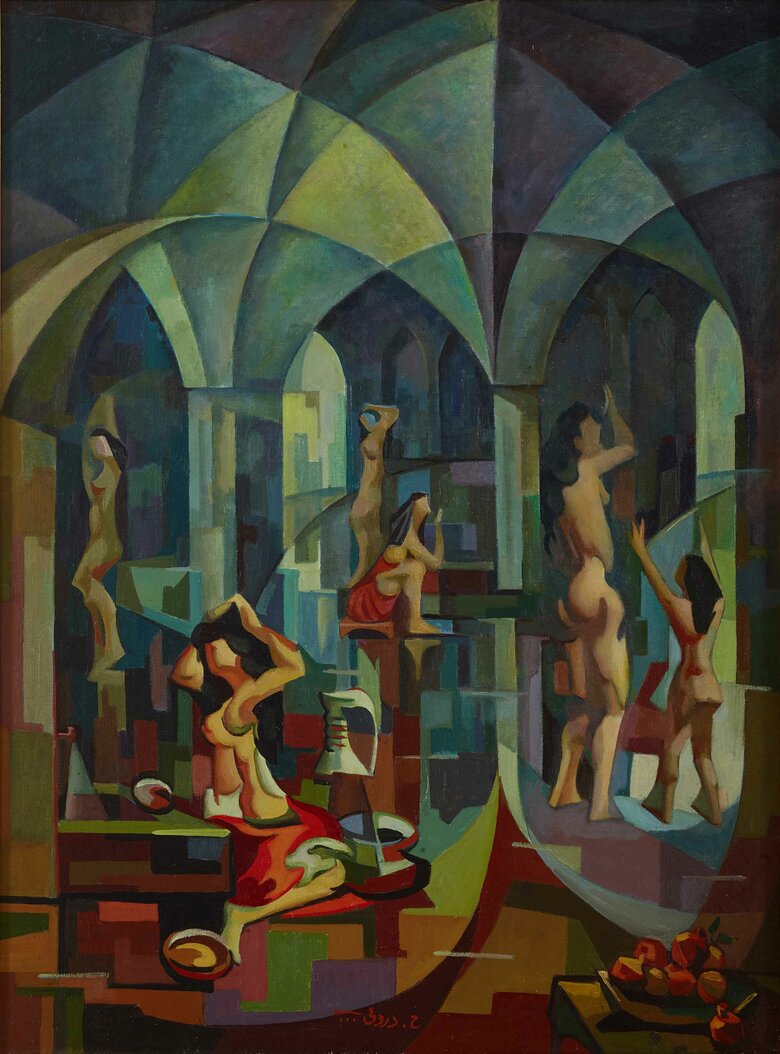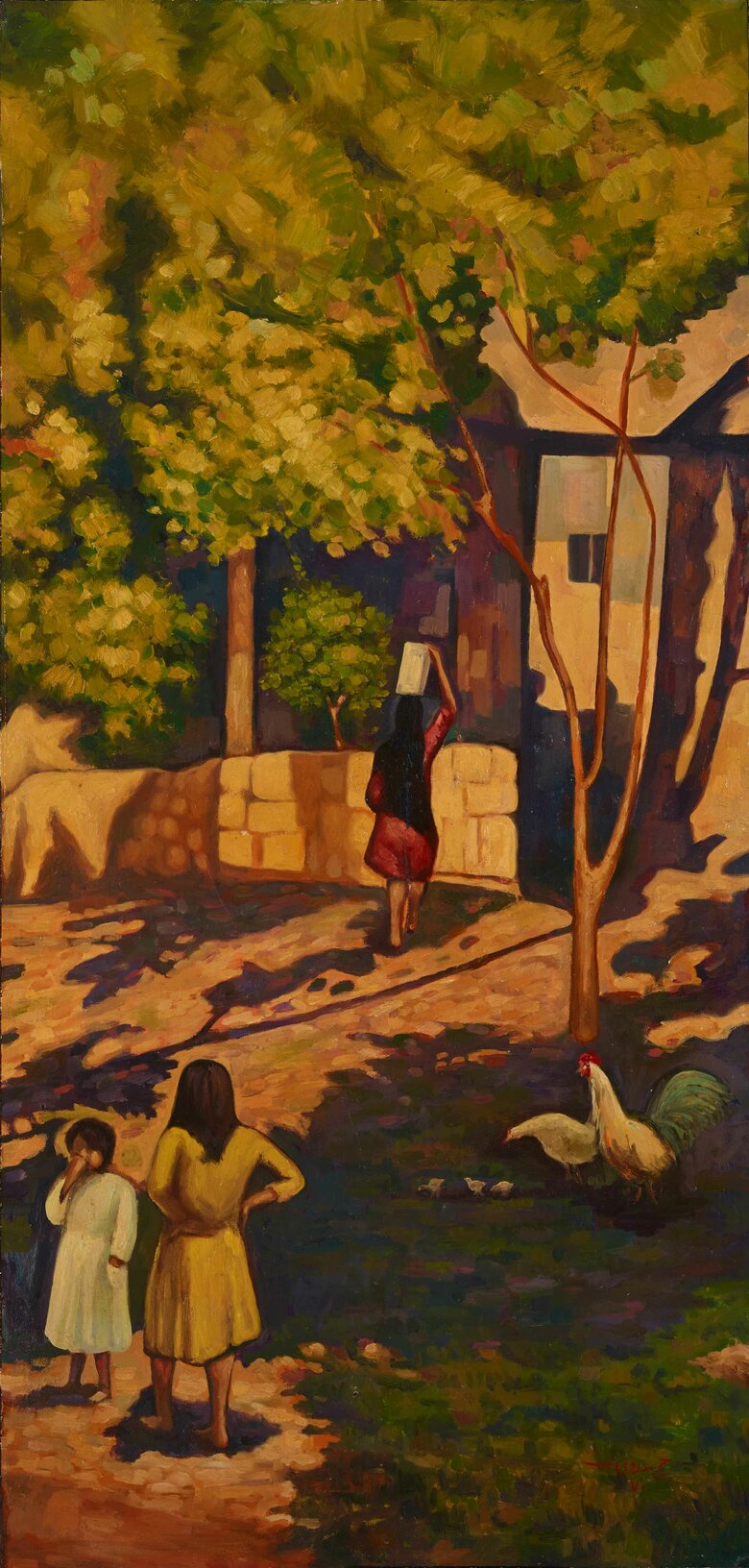Born in al-Sadriya, a working-class neighborhood of Baghdad, in 1914, Hafidh Droubi lost his father at a young age. Raised by his mother and his uncle in a religious family environment, he...
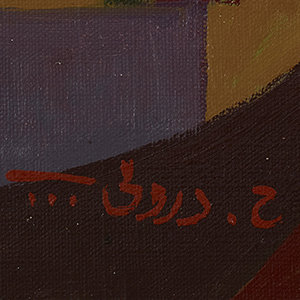

HAFIDH DROUBI, Iraq (1914 - 1991)
Bio
Written by ARTHUR DEBSI
Born in al-Sadriya, a working-class neighborhood of Baghdad, in 1914, Hafidh Droubi lost his father at a young age. Raised by his mother and his uncle in a religious family environment, he started his education with Qur’anic studies at the Mohammad Al-Alfei mosque, later learning painting at Al-Owainah School.
He began to show an inclination towards art by the age of five when he carefully observed his mother making embroideries with some dexterity and would paint anything that fascinated him through the embroidery motifs and colors.
The year 1931 marked the first major step of his artistic career, as through his participation in the Industrial and Agricultural Fair of Baghdad, he grew acquainted with fellow Iraqi artists Faik Hassan (1914-1992) and Jewad Selim (1919-1961). All three artists would grow to be hugely influential figures in the development of Iraqi modern art. Five years later, Droubi held his first solo exhibition, which included twenty works and aroused the interest of Prime Minister Yassin al-Hashemi (1884-1937). He thus became a member of the second generation of Iraqi students to receive a scholarship from the government to study abroad, staying in Rome from 1937 to 1938 to train under the Italian artist Carlo Siviero (1882-1953). There, he was able to explore Western art traditions in-depth but was obligated to leave the city after the outbreak of World War II. In 1945, he returned to Europe to complete his studies at Goldsmiths College, London, from which he graduated in 1951.
Upon his return to Iraq during the Second World War, Hafidh Droubi became an active contributor to the elaboration of a local art scene by getting involved in education and working to broaden the practice of plastic arts in Iraq. For example, alongside Faik Hassan (1914-1992) and ‘Atta Sabri (1913-1987), he helped to establish the curriculum for the drawing department at the nascent Institute of Fine Arts in Baghdad in 1939. In 1941, the same three painters were called upon to restore ancient Mesopotamian artifacts for the Iraq Museum, subsequently learning more about their country’s cultural history than they had been taught during their Eurocentric educations. In 1942, Droubi opened the country’s first free painting studio, providing the curious with an introduction to artmaking and furnishing budding artists with a place to hone their craft. Other artists’ studios would follow Droubi’s example, including the studio at the Faculty of Arts and Sciences at Baghdad University. At this time, King Faisal II (r. 1935-1958) was actively involved in crafting a new, modern image for his country, and the growth of the cultural sector was significant to his agenda. Iraqi artists were thus met with significant governmental support in their efforts, including Droubi. Along with ‘Atta Sabri, Jewad Selim, Abd al-Qadir al-Rassam (1882-1952) and Akram Shoukri (1910-1986), he co-founded the country’s primary association of artists, the Friends of Art Society (Jama’at Asdiqa al-Fann), also known as Société Primitive (Jama’at al-Bida’iyyin), in 1941. The group was not elite or exclusive but rather sought to gather established artists and amateurs alike, alongside architects, calligraphers, and other creatives to nourish the creative spirit of the rapidly modernizing country.
Returning from London in 1951, Hafidh Droubi participated in the first exhibition of the Baghdad Group for Modern Art, established earlier that year by Jewad Selim and Shaker Hassan al-Said. He left the Baghdad Group in 1953, encouraged by his students to found his own group, as Selim and Faik Hassan (1914-1992) had already done. Thus was born the Impressionist Group (Jama’at al-Intiba’yyin), which operated in correlation with his career as an art educator. The group did draw inspiration from the European movement of the same name, but in an unconventional sense. While most looked to painters like Monet and Sisley for their treatment of ephemeral light and their use of hurried, expressive brushstrokes, Droubi seized upon their technique of painting landscapes en plein-air. For Droubi, to be an impressionist was to be a painter of nature, thus inspired by the beauty of the Iraqi landscape rather than by canvases in Paris. Over the course of a decade, many artists –including Khalid al-Jadir (1914-1990), ‘Ala Hussein Bashir (b.1939) and Saad al-Ta’i (b.1935)–aligned themselves with this group, which distinguished itself aesthetically and thematically from the Baghdad Group by its emphasis on landscape. Yet, as al-Ta’i suggested in 1963, the celebratory view of nature and folklore that these artists shared at the outset was not enough to bridge the differences between members’ practices; the diversity of the group ultimately made it impossible to define its originality.[1] More than a specific theory or concept of art, it seemed, Droubi was the true link between the “Impressionists.”
The career of Hafidh Droubi spanned an incredibly tumultuous time in Iraqi history. Born during the British Mandate, the artist lived to see the establishment and overthrow of the Hashemite monarchy, two more military coups, and the increasingly dictatorial presidency of Saddam Hussein; remarkably, though his art practice weathered all of these regime shifts, it did not generally engage directly with the changing political climate. Instead, his oeuvre shows the interest of the artist in experimenting with different tendencies rather than affirming any particular political stance. As modern Iraqi artistic and political movements evolved in tandem, Droubi drew inspiration from his environment and its cultural richness. Nicknamed the ‘City Painter,’ he illustrated various aspects of mundane, daily life in Baghdad, painting its streets, its marketplaces, its coffee shops, and other places animated by the hustle and bustle of ordinary people. ‘Baghdad is my soul, my mother and my everything,’[2] the painter famously said. This source of inspiration celebrates a continuity with the local past, incorporating references to Islamic and Mesopotamian cultural heritage without asserting that such references were necessary to make a work of art “authentically Iraqi.” In 1955, he declared during the first exhibition of the Impressionist Group that he considered an artwork to be Iraqi as long as the subject is Iraqi – giving little importance to the style.[3] Hence, the vast majority of his works tackles similar topics all inherent to Iraqi visual culture. In the oil on wood Hammam (c.1960), he recalls the traditional public bath in the Arab-Islamic world, historically a hub of social life. In depicting these nude figures with their long hair exposed, he brings the spectator into an intimate, sensual moment, which plays out against an unmistakably Islamic arcade of pointed arches. Since appearing in the construction of the Al-Aqsa mosque, which dates from less than a century after the death of the Prophet, the pointed arch has been widely used in the erection of both religious and secular edifices throughout the Arab world and is today considered a marker of Islamic architectural identity. Although this local architecture had always surrounded them, the first Iraqi artists did not always pay attention to it, convinced by the colonial culture that their own civilizational legacy was retrograde in comparison to modern Europe. In an untitled painting from 1967 and Ghoroub ‘alaa Dijla (Sunset over the Tigris), executed in 1970, he celebrated the belonging to Mesopotamia, a land with thousands of years of culture to which Iraqis are the legal and historic heirs. The two cockerels refer to the symbolic image of the rooster, which appears frequently on Mesopotamian artefacts, especially seals. The bird is often associated with Nusku, the Sumerian god of light and fire, because its crowing announces the apparition of the first rays of the sun. Here, Hafidh Droubi depicted what may be a cockfight, a form of gambling entertainment still practiced in Iraq. In his plastic language, the idea of continuity between the present and the past is important, linking something as common as a round of gambling to something as profound as the ancient god of light and fire. This continuity is also represented by the Tigris itself, which has crossed the country for millennia and successively hosted the Sumerian, Babylonian, and Assyrian civilizations.
In evoking the “Iraqiness” of his scenes, Droubi does not play by conventional aesthetic rules, but rather restructures forms and colors. The style of his mature career plays with the liminal spaces between figuration and abstraction. He abandons linear perspective for two-dimensional representation, flattening the foreground and superimposing visual elements in elevation from the supposedly closest to the furthest. He paints the same scene from multiple perspectives, giving us a vertiginous view of an object’s many angles at once. Attentive to the lines and silhouettes of the natural or human motifs, he reduces them to simple, geometrical shapes like the square or the triangle, assembling these shapes to fill the canvas as though constructing a collage. His canvases become a laboratory for experimenting with colors and light, integrating flat and complementary colors to establish a sort of perspective with a gradation: the more saturated colors come to the front, whereas the darkest and most muted recede. The chromatic intensity of Droubi’s work makes a profound impact on the spectator, for whom the paintings provide a sensory experience that goes beyond the evocation of depth.
Although commonly affiliated with impressionism, Hafidh Droubi resisted easy categorization throughout his career. “As I am an artist,” he noted in the 1970s, “I paint what I feel, and my belonging to a certain school will not have any inhibiting effect on me”[4]. A painter of nature and quotidian life, his pleasure in reinventing the everyday shines through his landscapes, genre scenes, and still lifes, imbuing paintings of every style and from every stage of his career. The artist, who passed away in 1991 in Baghdad, is remembered as a dedicated teacher and is celebrated today as a major driving force in the development of Iraqi arts education.
Notes
[1] Naef, Silvia. À la Recherche d’une Modernité Arabe, L’Évolution des Arts Plastiques en Egypte, eu Liban et en Irak. Genève, Switzerland: Slatkine Reprints, 1996. [PP.251-252].
[2] Hafidh Droubi in an interview with Al-Rewaq magazine in 1977 quoted by his granddaughter Mina Aldroubi in Aldroubi, Mina. “My Grandfather, the Man Who Coloured the Streets of Baghdad.” The National. Accessed January 28, 2020. https://www.thenational.ae/arts-culture/art/my-grandfather-the-man-who-coloured-the-streets-of-baghdad-1.671211.
[3] Naef, Silvia. À la Recherche d’une Modernité Arabe, L’Évolution des Arts Plastiques en Egypte, eu Liban et en Irak. Genève, Switzerland: Slatkine Reprints, 1996. [P.253]
[5] Hafidh Droubi quoted in Salim, Nizar. Art Contemporain En Irak - Livre I, Peinture. Lausanne, Switzerland: Sartec, 1977. [P.152]
Sources
Ali, Wijdan. Modern Islamic Art: Development and Continuity. Gainesville (Fla.), USA: University Press of Florida, 1997.
Aldroubi, Mina. “My Grandfather, the Man Who Coloured the Streets of Baghdad.” The National. Accessed January 28, 2020. https://www.thenational.ae/arts-culture/art/my-grandfather-the-man-who-coloured-the-streets-of-baghdad-1.671211.
Bahrani, Zainab. Mesopotamia: Ancient Art and Architecture. London, UK: Thames & Hudson, 2017.
Draper, Peter. “Islam and the West: The Early Use of the Pointed Arch Revisited.” Architectural History 48 (2005): 1–20. https://www.jstor.org/stable/40033831?seq=1.
Eigner, Saeb. Art of the Middle-East, Modern and Contemporary Art of the Arab World and Iran. London, UK: Merell Publishers Limited, 2011.
Ehrenberg, Erica, and Donald P. Hansen. Leaving No Stones Unturned: Essays on the Ancient Near East and Egypt in Honor of Donald P. Hansen. Winona Lake, IN, USA: Eisenbrauns, 2002.
Jabrā Jabrā Ibrāhīm. The Grass Roots of Iraqi Art. St. Helier, Jersey, C.I., UK: Wasit Graphic and Publishing Limited, 1983.
Lenssen, Anneka, A. Rogers, Sarah, and Shabout, Nada. Modern Art in the Arab World, Primary Documents. New York, USA: The Museum of Modern Art, 2018.
Naef, Silvia. À la Recherche d’une Modernité Arabe, L’Évolution des Arts Plastiques en Egypte, eu Liban et en Irak. Genève, Switzerland: Slatkine Reprints, 1996.
Naji, Ahmed. Under the Palm Trees: Modern Iraqi Art with Mohamed Makiya and Jewad Selim. New York, USA: Rizzoli International Publications Inc., 2019.
Ahmed, Modhir, Charles Pocock, and ʻAzzāwī Diyāʼ. Art in Iraq Today. Milan, Italy: Skira, 2011.
Pocock, Charles, and M. Shabout, Nada. Modern Iraqi Art: A Collection, [Exhibition catalogue, ‘Modern Iraqi Art: A Collection’, Dubai, Meem Gallery, May 13th 2013 – July 10th 2013]. Dubai, UAE: Meem Gallery, 2013.
Salim, Nizar. Art Contemporain En Irak - Livre I, Peinture. Lausanne, Switzerland: Sartec, 1977.
Shabout, Nada. Modern Arab Art: Formation of Arab Aesthetics. Gainesville, USA: University Press of Florida, 2015.
شاكر حسن السعيد، فنانون عراقيون، حافظ الدروبي، وزارة الثقافة والاعلام، دائرة الفنون التشكليلية، بغداد، ١٩٨٢.
(Al-Said Shaker Hassan, The Iraqi Artists, Hafidh al-Droubi, Minister of Culture and Education, Fine Arts Department, Bagdad, 1982.)
“Hafidh AL-DROUBI: Ibrahimi Collection.” Hafidh AL-DROUBI | Ibrahimi Collection. Accessed January 21, 2020. http://ibrahimicollection.com/node/63.
“Modern Art Iraq Archive.” Omeka RSS. Accessed January 12, 2020. https://artiraq.org/maia/.
CV
Selected Solo Exhibitions
2010
Commemoration of 19th anniversary of the artist, London, United-Kingdom
1980
Tribute to Hafidh Droub, Modern Art Museum, Bagdad, Iraq
1977
Al-Alawya Club, Bagdad, Iraq
1973
Al-Alawya Club, Bagdad, Iraq
1969
Al-Suleikh, Bagdad, Iraq
1951
Museum of Iraqi Fashion, Bagdad, Iraq
1936
The Teachers Club, Bagdad, Iraq
Selected Group Exhibitions
2022
Memory Sews Together Events That Hadn’t Previously Met, Sharjah Art Museum, Sharjah, United Arab Emirates
2018
A Century in Flux, Sharjah Art Museum, Sharjah, United Arab Emirates
2017
Mathaf Collection, Summary, Part 2, Mathaf: Arab Museum of Modern Art, Doha, Qatar
2016
The Short Century, Sharjah Museum, Sharjah, United Arab Emirates
2013
Modern Iraqi Art: A Collection, Meem Gallery, Dubai, United Arab Emirates
Art From Iraq, Al-Mashreq Gallery, Kuwait City, Kuwait
RE: Orient, Barjeel Art Foundation, Sharjah, United Arab Emirate
1977
الفن العراقي المعاصر (Contemporary Iraqi Art), Tunis, Tunisia
معرض الفان العراقي المعاصر، الأسبوع الثقافي العراقي (Exhibition of Contemporary Iraqi Art for Iraqi Cultural Week), Qatar, Kuwait, Bahrein
1976
Art Contemporain Irakien, Musée d’Art Moderne de la Ville de Paris, Paris, France
1974
The First Arab Art Biennale, Iraqi Pavilion, Bagdad, Iraq
1972
Al-Wasiti Festival, Bagdad, Iraq
1971
Exhibition of the Plastic Arts, Marbad Poetry Festival, Basra, Iraq
1968
Last Exhibition of the Group of the Impressionists, Bagdad, Iraq
1967
Exhibition of the Group of the Impressionists, Iraqi Artists Association Hall, Bagdad, Iraq
1966
Exhibition of the Iraqi Artists Association, Bagdad, Iraq
1965
Exhibition of the Group of the Impressionists, Modern Art Museum, Bagdad, Iraq
Itinerant exhibition of the Iraqi Artists Association, Rome, Budapest, Vienna, London
1964
Exhibition of the Iraqi Artists Association, Bagdad, Iraq
1962
Exhibition of the Iraqi Artists Association, Bagdad, Iraq
1961
Exhibition of the Iraqi Artists Association, Bagdad, Iraq
1959
Iraqi Modern Art Exhibition, State Museum of Oriental Art, Moscow, Russia
Iraqi Modern Art Exhibition, Azerbaijan National Museum of Oriental Art, Baku, Azerbaijan
Iraqi Modern Art Exhibition, Museum of Western and Eastern Museum of Art, Odessa, Ukraine
1957
The Bagdad Exhibition of Painting and Sculpture, Mansour Club, Bagdad, Iraq
1956
Exhibition of contemporary Iraqi art, Beirut, Lebanon
Second Exhibition of the Group of the Impressionists, Bagdad, Iraq
1955
First exhibition of the Group of the Impressionists, Bagdad, Iraq
1951
First exhibition of the Group of Bagdad for Modern Art, Museum of Ancient Costume, Baghdad, Iraq
1948
Iraqi English Club, London, United-Kingdom
1943
Exhibition of the Society of the Friends of Art, Baghdad, Iraq
The National Gallery of Pictures, Iraqi Museum, Baghdad, Iraq
1942
Exhibition of the Society of the Friends of Art, Baghdad, Iraq
1941
Exhibition of the Society of the Friends of Art, Baghdad, Iraq
1931
Industrial and Agricultural Fair, Bagdad, Iraq
Awards and Honors
1972
Al-Wasiti Festival, Baghdad, Iraq
Collections
Jordan National Gallery of Fine Arts, Amman, Jordan
Mathaf: Arab Museum of Modern Art, Doha, Qatar
The Barjeel Art Foundation, Sharjah, United Arab Emirates
The Ibrahimi Collection, Amman, Jordan
The National Museum of Modern Art, Baghdad, Iraq
The Ramzi and Saeda Dalloul Art Foundation, Beirut, Lebanon
Press
طباعة الصفحة - حافظ ألدروبي فنان الإنسان والأرض.pdf
elaph.pdf
AlJarida.pdf
HafidhDroubi_My Grandfather, the Baghdadi Artist_Majalla Magazine_Press.pdf
الدروبي يستثير وجع العراقيين في معرض للوحاته بلندن,.pdf
19 عاما على رحيل رسام بغداد الفنان حافظ الدروبي.pdf
Hafidh Al Droubi _ Barjeel Art Foundation.pdf
وزارة الثقافة تتسلّم لوحة «بائع الخضار» لحافظ الدروبي – جريدة الصباح الجديد.pdf
حافظ الدروبي وبعده عن عوامل الصخب والإثارة _ الصدى.نت.pdf
Al Rasheed.pdf
بسمه طالب فتحي - الفنان حافظ الدروبي.pdf
حافظ الدروبي وبعده عن عوامل الصخب والإثارة.pdf
HAFIDH DROUBI Artwork
Become a Member
Join us in our endless discovery of modern and contemporary Arab art
Become a Member
Get updates from DAF
Follow Artists
Save your favourite Artworks
Share your perspectives on Artworks
Be part of our community
It's Free!
We value your privacy
TermsCookiesPrivacy Policies
Become a Member
Get updates from DAF
Follow Artists
Save your favourite Artworks
Share your perspectives on Artworks
Be part of our community
It's Free!
We value your privacy
TermsCookiesPrivacy Policies
Become a Member
Get updates from DAF
Follow Artists
Save your favourite Artworks
Share your perspectives on Artworks
Be part of our community
It's Free!
We value your privacy
TermsCookiesPrivacy Policies
Welcome to the Dalloul Art Foundation
Thank you for joining our community
If you have entered your email to become a member of the Dalloul Art Foundation, please click the button below to confirm your email and agree to our Terms, Cookie & Privacy policies.
We value your privacy, see how
Become a Member
Get updates from DAF
Follow Artists
Save your favourite Artworks
Share your perspectives on Artworks
Be part of our community
It's Free!
We value your privacy
TermsCookiesPrivacy Policies


